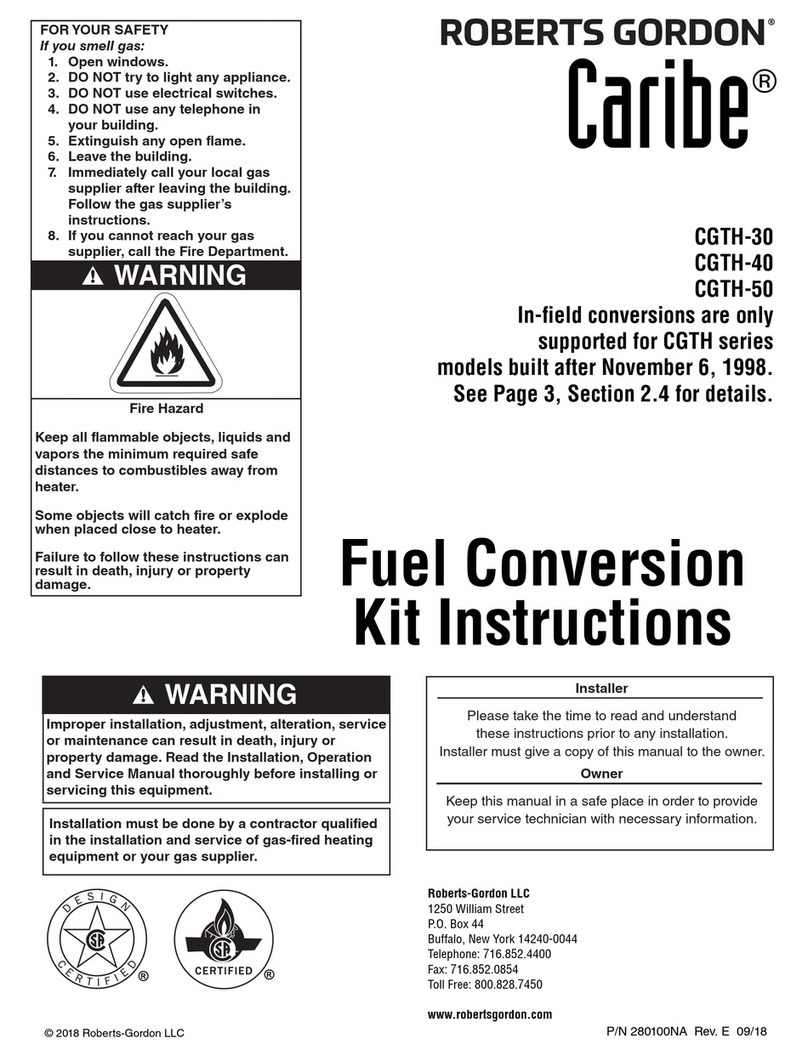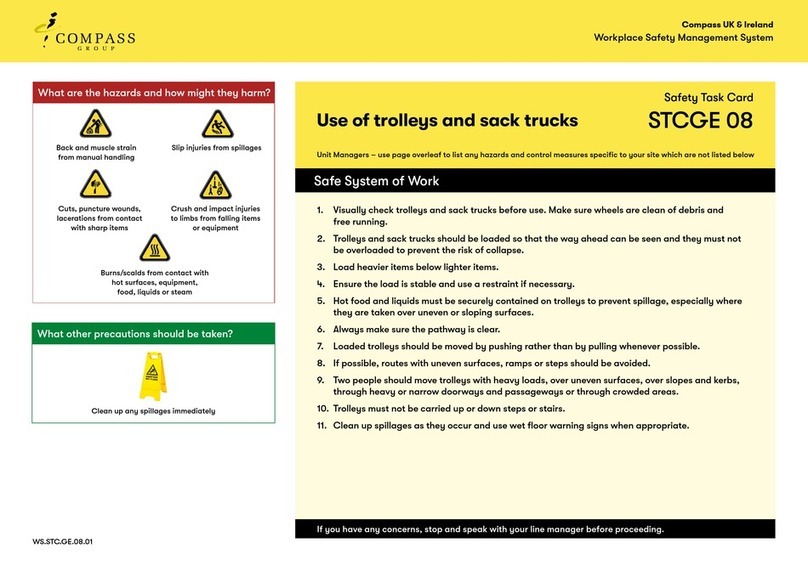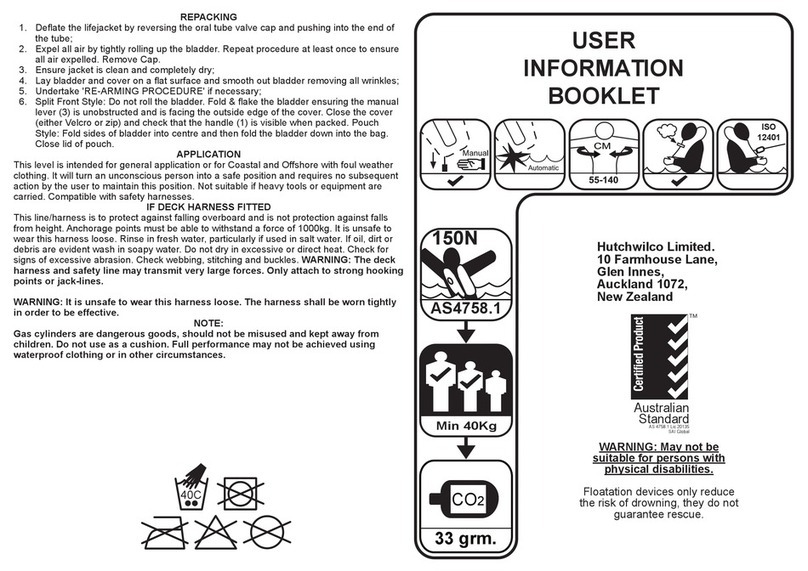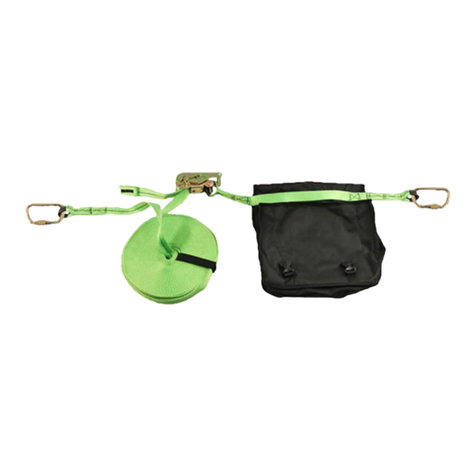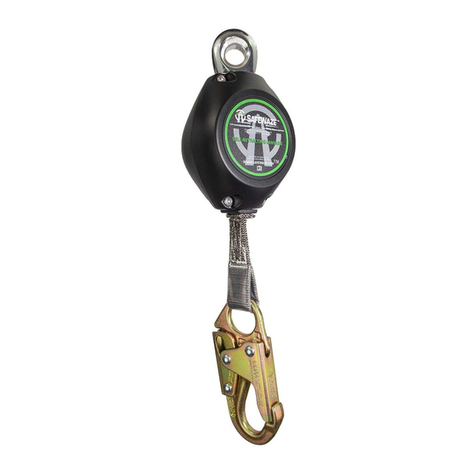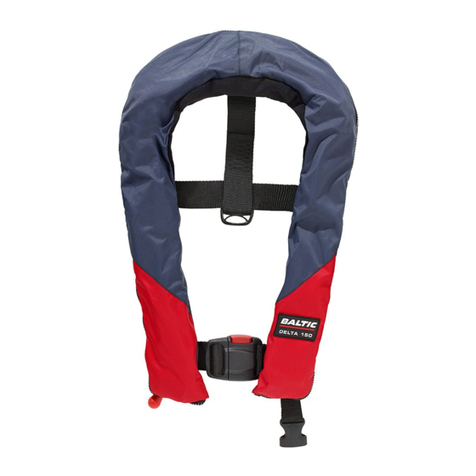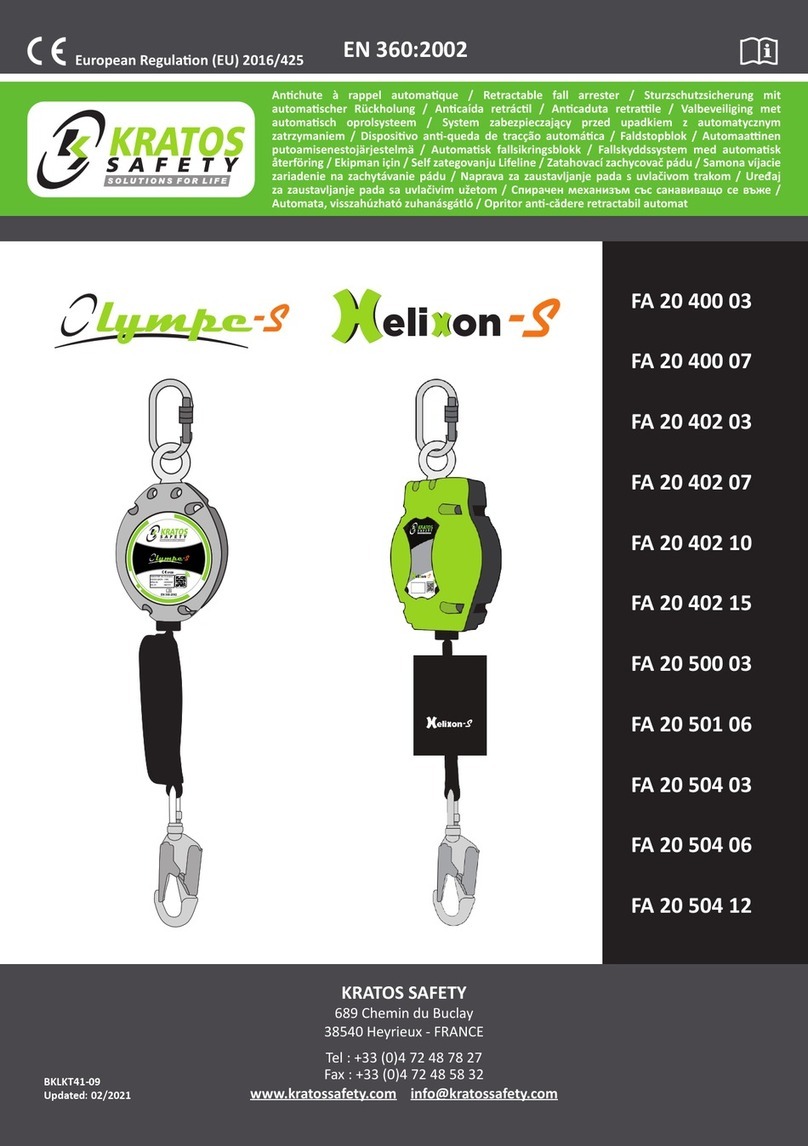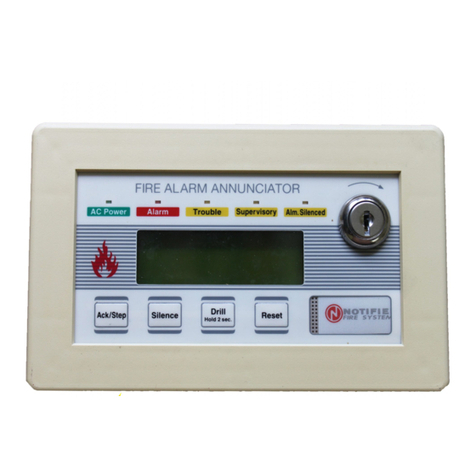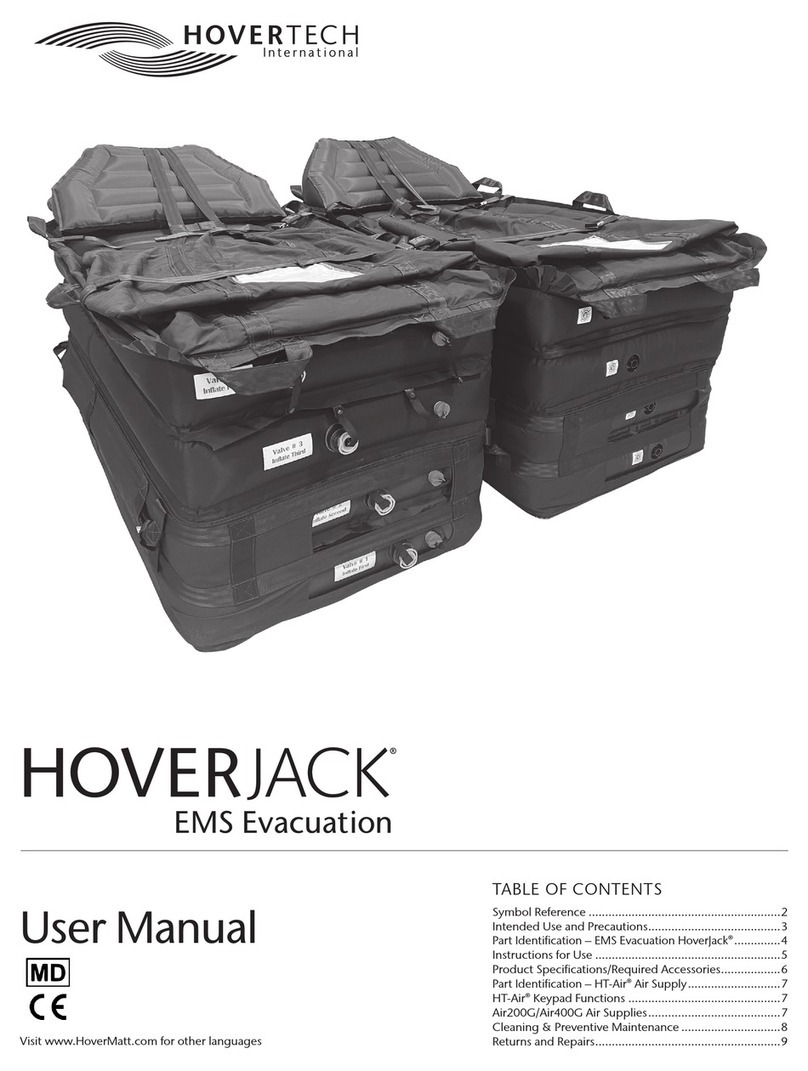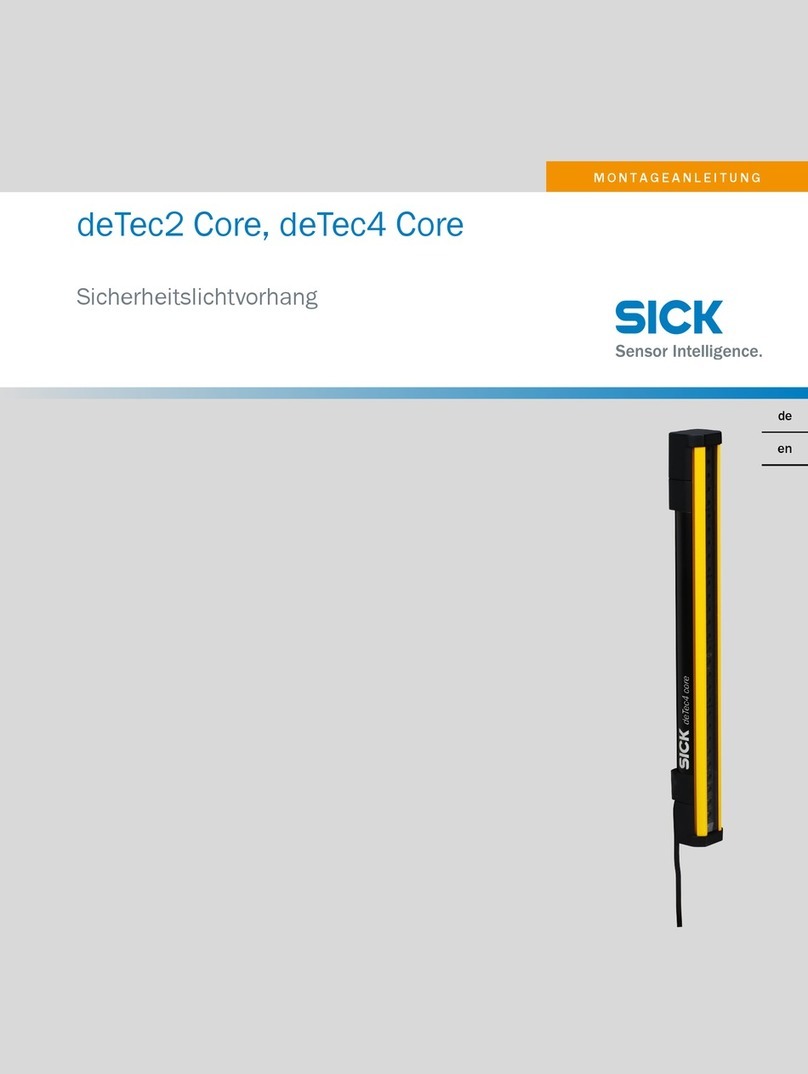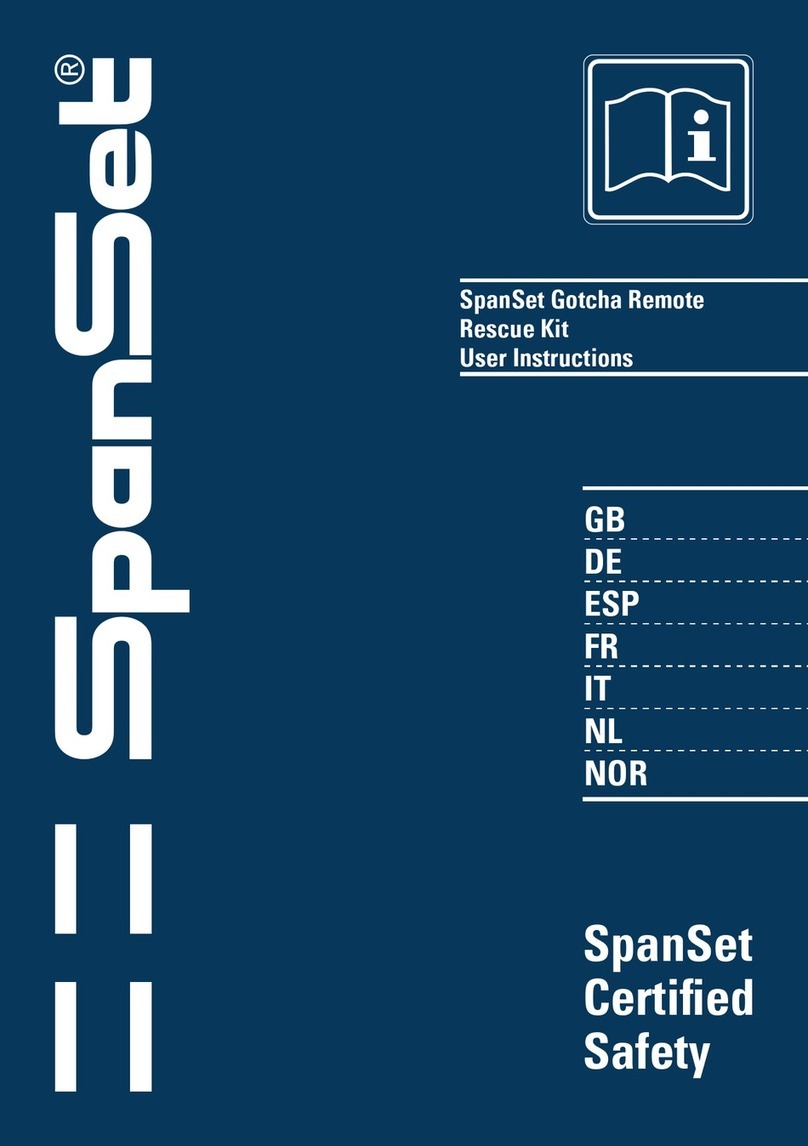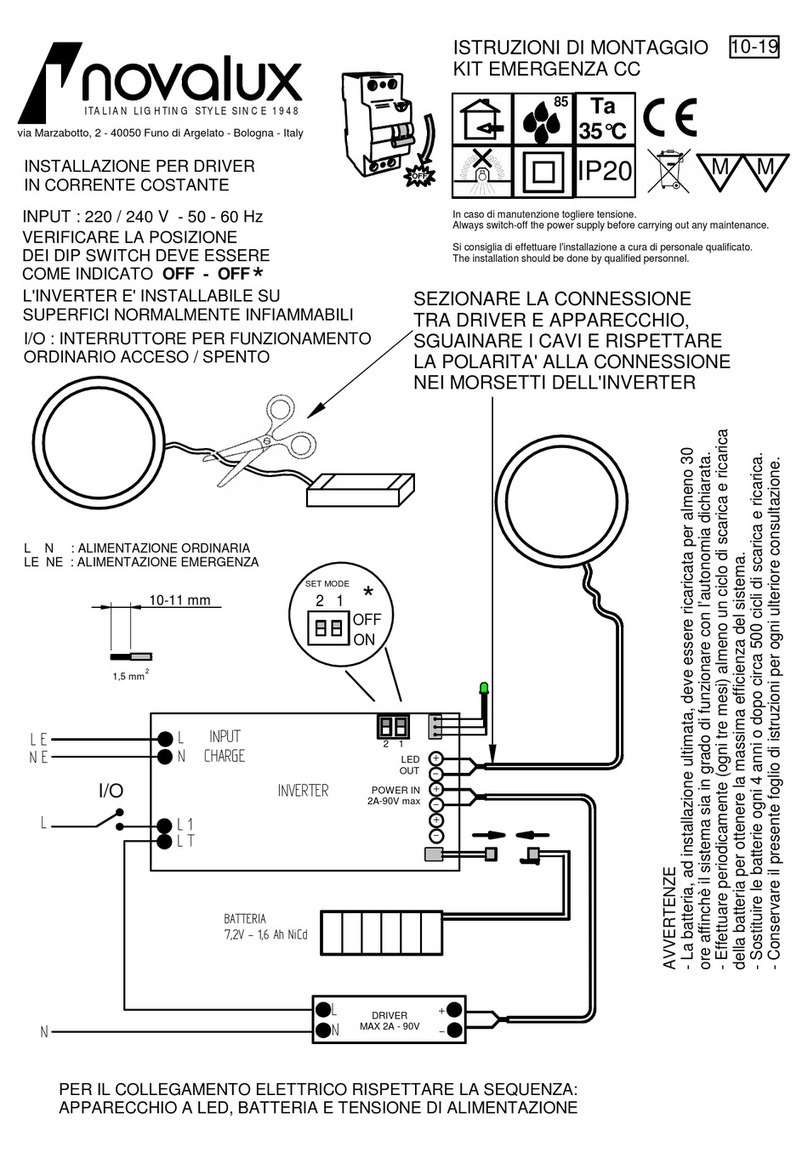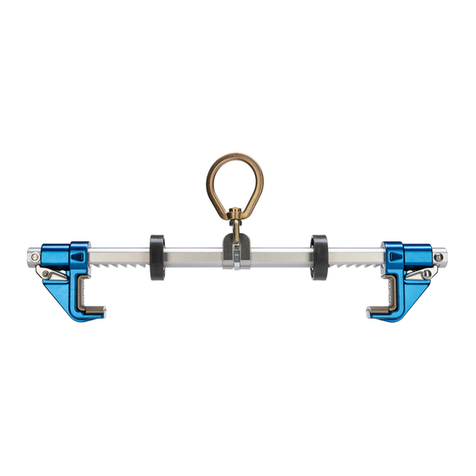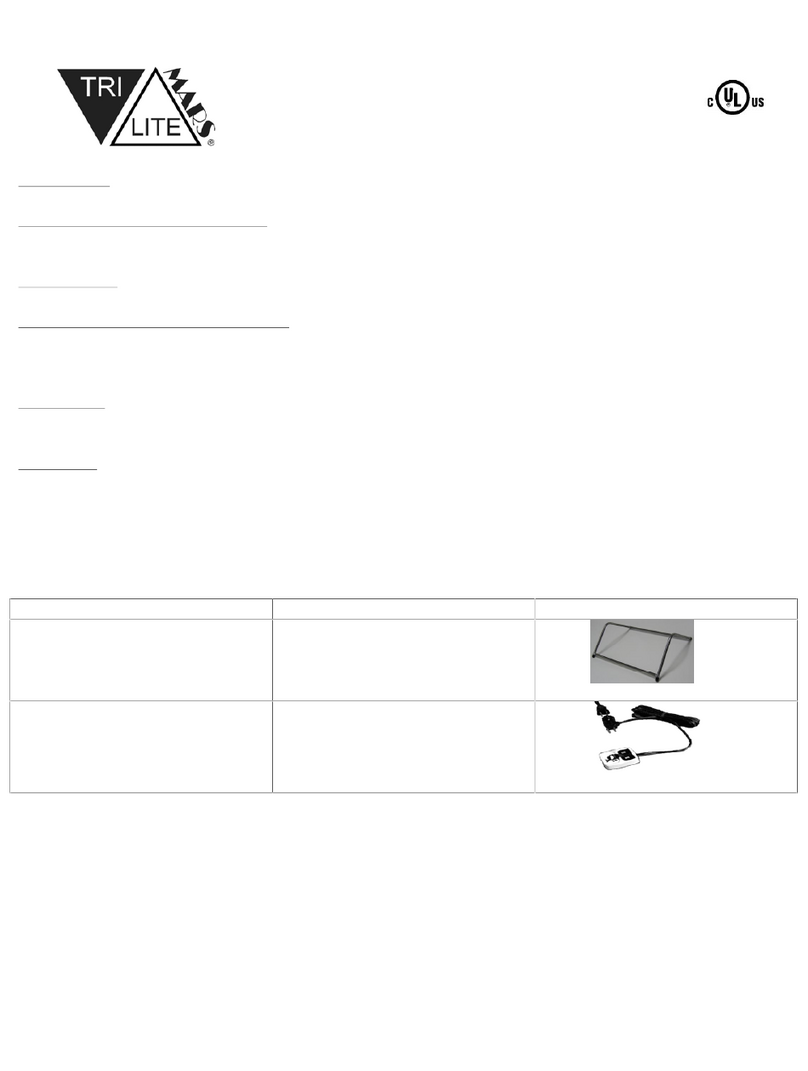Reliance 500 Series User manual

INSTRUCTIONS FOR USE
500X Series Rope Grabs
Phone : 281-930-8000
Toll Free : 888-362-2826
Fax : 281-930-8666
Complies with the current ANSI Z359.1-2007 and
all applicable OSHA regulations and requirements.
Reliance Industries
P.O. Box 2046
Deer Park, TX 77536
5000 Rope Grab
5001 Rope Grab

Page 2
User Instructions
Reliance Rope Grabs
This manual is intended to meet the Manufacturer’s Instructions as required by
the current ANSI Z359.1(2007) ,and should used as part of an employee train-
ing program as required by OSHA.
WARNING: This product is one part of a personal fall arrest, restraint, work
positioning, personnel riding, climbing, or rescue system. Without the other nec-
essary components in such sub-systems the Rope Grab itself serves no useful
purpose. The user must follow the manufacturer’s instructions for each com-
ponent of the system. These instructions must be provided to the user before
using this product and retained for ready reference by the user. The user must
read, understand (or have explained), and heed all instructions, labels, mark-
ings and warnings supplied with this product and with those products intended
for use in association with it before using this equipment. It is the responsibility
of the user to assure they are familiar with these instructions, and are trained
in the correct care and use of this equipment. User must also be aware of the
operating characteristics, application limits, and the consequences of improper
use of this equipment. Manufacturer’s instructions must be followed for proper
use and maintenance of this equipment. National standards and state, provin-
cial and federal laws require the user to be trained before using this product.
This manual can be used as part of a user safety training program that is ap-
propriate for the user’s occupation.
IMPORTANT: Alterations or misuse of this product or failure to follow in-
structions may result in serious injury or death. If you have questions on
the use, care, or suitability of this equipment for your application, contact RELI-
ANCE Fall Protection for information.
APPLICATIONS
1) Purpose: Reliance rope grabs are to be used as part of a personal fall arrest,
work positioning, or restraint system. Rope grabs are available with or without
an attached energy absorber. Applications include: inspection work, construc-
tion and demolition, maintenance, oil production, window washing, and other
activities where there exists the need for fall arrest or restraint..
2) Limitations: Consider the following application limitations before using this
equipment:
a) Capacity: This equipment is designed for use by one person with a com-
bined weight (including tools, clothing, etc.) of no more than 310 lbs.
b) Free Fall: Restraint systems must be rigged such that there is no possible
vertical free fall. Personal fall arrest systems must be rigged in such a

Instructions for Use
Page 3
way to limit the free fall to six feet (ANSI Z359.1). See associated con-
necting subsystem manufacturer’s instructions for further information.
c) Fall Clearance: Make certain that enough clearance exists in your fall
path to prevent striking an object. The amount of clearance required is
dependent upon the type of connecting subsystem used (lanyard, life-
line), the anchorage location, and the amount of stretch in the lifeline.
See page 10 for more information on determining fall clearance.
d) Corrosion: Do not leave this equipment for long periods in environments
where corrosion of metal parts could take place as a result of vapors from
organic materials. Sewage and fertilizer plants, for example, have high
concentrations of ammonia. Use near seawater or other corrosive envi-
ronments may require more frequent inspections or servicing to ensure
corrosion damage is not affecting the performance of the product.
e) Chemical Hazards: Solutions containing acids, alkali, or other caustic
chemicals, especially at elevated temperatures, may cause damage to
this equipment. When working with such chemicals, frequent inspection
of this equipment must be performed. Consult Reliance if doubt exists
concerning using this equipment around chemical hazards.
f) Heat: This equipment is not designed for use in high temperature environ-
ments. Protection should be provided for this equipment when used near
welding, metal cutting, or similar activities. Hot sparks may burn or dam-
age this equipment. Contact Reliance for details on high temperature
environments.
g) Electrical Hazards: Due to the possibility of electric current owing
through this equipment or connecting components, use extreme caution
when working near high voltage power lines.
h) Component Compatibility: The rope grab addressed by these instruc-
tions is intended for use with Reliance lifelines and lifeline subsystems
only. Consult Reliance if you are considering using this equipment with
other lifelines or lifeline subsystems. See ‘System Requirements’.
i) Training: This equipment is to be used by persons who have been prop-
erly trained in its correct application and use.
3) Applicable Standards: Refer to national standards, including the ANSI
Z359 family of standards on fall protection, ANSI A10.32, and applicable lo-
cal, state, and federal (OSHA) requirements governing occupational safety, for
more information on work positioning systems.
SYSTEM REQUIREMENTS
1) Compatibility of Components and Subsystems: This equipment is de-
signed for use with Reliance approved components and subsystems. Substitu-
tions or replacements made with non-approved components or subsystems

Page 4
may be incompatible, and may jeopardize the safety and reliability of the com-
plete system.
2) Compatibility of Connectors: Connectors are considered to be compatible
with connecting elements when they have been designed to work together in
such a way that their sizes and shapes do not cause their gate mechanisms to
inadvertently open regardless of how they become oriented. Contact Reliance
if you have any questions about compatibility. Connectors (hooks, carabiners,
and D-rings) must be capable of supporting at least 5,000 lbs. (22.2 kN). Con-
nectors must be compatible with the anchorage or other system components.
Do not use equipment that is not compatible. Non-compatible connectors may
unintentionally disengage. Connectors must be compatible in size, shape, and
strength. Self locking snap hooks and carabiners are required by ANSI Z359.4
and OSHA.
3) Making Connections: Only use self-locking snap hooks and carabiners with
this equipment. Only use connectors that are suitable to each application. En-
sure all connections are compatible in size, shape and strength. Do not use
equipment that is not compatible. Ensure all connections are fully closed and
locked . Reliance connectors (snap hooks and carabiners) are designed to be
used only as specied in each product’s user’s instructions. See Figure 1 for in-
appropriate connections. Snap hooks and carabiners should not be connected:
a) To a D-ring to which another connector is attached.
b) In a manner that would result in a load on the gate.
Figure 1

Instructions for Use
Page 5
c) In a false engagement, where features that protrude from the snap hook or
carabiner catch on the anchor and without visual conrmation seems to
be fully engaged to the anchor point.
d) To each other.
e) Directly to webbing or rope lanyard or tie-back (unless the manufacturer’s
instructions for both the lanyard and connector specically allows such
a connection).
f) To any object which is shaped or dimensioned such that the snap hook or
carabiner will not close and lock, or that roll-out could occur. (Figure 2)
4) Anchorage Strength:
a) Fall Arrest: Anchorages selected for personal fall arrest systems
(PFAS) shall have a strength capable of sustaining static loads, ap-
plied in the directions permitted by the PFAS, of at least; (A) 3,600
lbs. (16kN) when certication exists (see ANSI Z359.1 for certica-
tion denition), or (B) 5,000 lbs. (22kN) in the absence of certication.
When more than one PFAS is attached to an anchorage, the anchor-
age strengths set forth in (A) and (B) above shall be multiplied by the
number of personal fall arrest systems attached to the anchorage.
If the connecting element that a snap hook (shown) or carabiner attaches
to is undersized or irregular in shape, a situation could occur where the
connecting element applies a force to the gate of the snap hook or carabi-
ner. This force may cause the gate (of either a self-locking or a non-locking
snap hook) to open, allowing the snap hook or carabiner to disengage
from the connecting point.
Figure 2
Small ring or other
non-compatibly shaped
element
1. Force is applied to
the snap hook.
2. The gate presses
against the
connecting ring
3. The gate opens,
allowing the snap
hook to slip off.

Page 6
Per OSHA 1926.500 and 1910.66; Anchorages used for attachment of
PFAS shall be independent of any anchorage being used to support or
suspend platforms, and capable of supporting at least 5,000 lbs. (22kN)
per user attached, or be designed, installed, and used as part of a com-
plete PFAS which maintains a safety factory of at least two, and is super-
vised by a qualied person
b) Restraint: Anchorages must be capable of supporting a minimum of 3,000
lbs. per system attached. WARNING: Restraint anchorages may only be
used where there is no possible vertical free fall. Restraint anchorages
do not have sufcient strength for fall arrest. Do not connect personal fall
arrest systems to restraint anchorages.
5) Lifelines: Reliance rope grabs are to be used with Reliance lifelines and life-
line subsystems. Lifelines used with the 5000 and 5001 are: 5/8-inch (16mm)
diameter polyester blend Reliance 5010 Series vertical lifeline rope assemblies.
See appropriate lifeline instructions for rope elongation factors. The following
lifeline requirements must be followed:
a) Size: The 5000/5001 rope grabs are designed to be used on Reliance
5010 Series 5/8-inch (16mm) diameter vertical lifelines. Undersized rope
may not allow the rope grab to lock properly and may cause excessive
stopping distances. Oversized rope may impede rope grab mobility on
the lifeline. It is recommended that lifeline diameter be 5/8 inch, ±1/32
inch (0.8mm).
b) Construction: Three-strand lay rope constructions are recommended,
but other constructions may also be acceptable. Consult Reliance if you
are considering using this equipment with other lifeline constructions.
Braided, double braided, hollow braided, or other types of rope construc-
tions must not be used. When selecting the lifeline, choose a rope with
a rm lay. Inspect the lay of the rope by grasping it several feet from the
end between the thumb and index nger. You should not be able to easily
squeeze or atten the rope. Untwisting should be difcult and the rope
should spring back to its original shape.
c) Material: Reliance recommends selecting lifeline ropes made from poly-
ester bers. Polyester has less stretch and less swelling due to moisture
absorption than nylon. Ropes made solely of polypropylene, polyethyl-
enes, or other olens must not be used. Ropes made from cotton, sisal,
hemp, abaca (manila), or other plant/animal bers must not be used.
ANSI Z359.1 requires rope used in vertical lifelines to be made of vir-
gin synthetic materials having strength, aging resistance, abrasion re-

Instructions for Use
Page 7
sistance, and heat resistance characteristics equivalent or superior to
polyamides.
d) Strength: Select a lifeline which, when terminated and installed, will re-
tain a minimum strength of 5,000 lbs. (22kN) per ANSI Z359.1. Selection
must account for strength reduction factors, such as sharp edges and
degrading factors (i.e. chemicals).
NOTE: Per ANSI Z359.1; Knots shall not be used for load bearing end termina-
tions, but may be an acceptable means of securing the free end of the lifeline
at ground level.
6) Lanyards: The 5000/5001 rope grab must not be used with a lanyard con-
necting subsystem exceeding 3 feet (0.9m) in length. For fall arrest systems
Reliance recommends using energy absorbing lanyards incorporating self lock-
ing snap hooks. Lanyards labeled ANSI A10.14 Type II must not be used for
fall arrest applications. All lanyards must have a minimum breaking strength of
5,000 lbs.
7) Body Support: The recommended body support for fall arrest applications is
a full body harness, for restraint applications a full body harness with positioning
D-rings is recommended.
NOTE: Only lifeline ropes which meet the size, construction, and material prop-
erties required for compatible use with this rope grab may be used. Applications
such as working near high voltage may require special lifeline materials, consult
Reliance before using such lifelines.
USE & OPERATION
1) Before each use of this equipment, carefully inspect it according to
steps listed in this manual. Do not use if inspection reveals an unsafe
condition.
2) Plan your fall arrest or restraint system before starting your work. Consider
all factors that affect your safety before, during, and after a fall. Refer to these
and related subsystem component instructions, and state and federal safety
regulations for guidance in planning your system. The following list gives some
important points to consider when planning your system:
a) Anchorage: Select a rigid anchorage point that is capable of supporting
the required loads. The anchorage location must be carefully selected
to reduce possible free fall and swing fall hazards and to avoid strik-
ing an object during a fall. For restraint systems the anchorage must be
located such that no vertical free fall is possible. For fall arrest systems
OSHA requires the anchorage be independent of the means suspending
or supporting the user.

Page 8
b) Free Fall: Do not work above the anchorage level, increased fall distance
will result. Personal fall arrest systems must be rigged such that the po-
tential free fall is never greater than six feet. Restraint systems must be
rigged such that there is no possible vertical free fall.
c) Fall Arrest Forces: The assembled fall arrest system must keep fall arrest
forces below 1,800 lbs. when used with a full body harness. Do not use
a body belt for fall arrest.
d) Swing Falls: Swing falls occur when the anchorage point is not directly
above the point where a fall occurs. The force of striking an object while
swinging can be great and cause serious injury. Swing falls can be mini-
mized by working as directly below the anchorage as possible. (Fig. 3)
e) Fall Clearance: Make certain enough clearance exists in your fall path
to prevent striking an object. The amount needed is dependent upon the
type of connecting subsystem used and anchorage location. (Fig. 4)
f) Sharp Edges: Avoid working where parts of the system will be in contact
with, or abrade against, unprotected sharp edges.
g) Rescue: The user must have a rescue plan and the means at hand to
implement it if a fall occurs.
h) After a Fall: Components which have been subjected to the forces of ar-
resting a fall must be removed from service immediately and destroyed.
i) General Use Considerations: Avoid working where lifeline may cross or
tangle with that of another worker. Do not allow the lanyard to pass un-
der arms or between legs. Do not clamp, tie, or other wise prevent the
rope grab lanyard connection handle from moving freely into the “locked”
position.
j) Sloped Roofs: Provisions must be made (warning lines, monitors, guard-
rails) to prevent swing falls from unprotected roof edges or corners. The
rope grab should be connected to the body support using a locking cara-
biner (direct connection) or a short lanyard. If a lanyard is used for con-
necting to the rope grab, keep the length as short as possible, and never
greater than three feet. The lifeline must be protected from contact with
sharp or abrasive edges and surfaces. The rope grab locking operation
must not be hindered by interference with the roof or objects on the roof
surface.
k) Unstable Surfaces: The rope grab is not suitable for use on unstable or
slowly shifting materials, such as sand or grain.
WARNING: Never connect more than one personal fall arrest or restraint sys-
tem to a single lifeline or rope grab. Follow manufacturer’s instructions for as-
sociated equipment used in your fall protection or restraint system. For custom
versions of this product, follow the instructions herein. If included, see supple-
mental instructions for additional information.

Instructions for Use
Page 9
3) Attaching the Rope Grab to the Lifeline - Model 5000
a) The arrows must point UP for the Rope Grab to function.
b) Rope must be threaded through the rope grab from the bottom of the
lifeline
c) The lifeline should be weighted or tied off at the bottom to assist in posi-
tioning the rope grab
d) Use 3-strand 5/8” (16mm) or 3/4” (19mm) dia. rope
e) Depress the ‘bridge’ of the rope grab and move the unit up and down the
rope after the rope has been threaded through the opening. The unit
should lock immediately and rmly upon release
f) Test the installation by pulling down on the ring to ensure that the mecha-
nism locks on to the rope
g) The anchor point should be capable of supporting a 5,000 lb (22.3kN)
static load and should be located directly above the user to minimize
swing falls, and should meet the strength requirements listed in 4) An-
chorage Strength on page 4
h) Lanyards should be selected to meet the application with a 5,000 lb
(22.3kN) tensile strength on all components. ANSI Z359.1 - a maximum
3 ft (.9m) lanyard
i) NOTE : When using a lanyard, your fall distance is twice the length of
the lanyard PLUS the deployed length of the shock absorber PLUS the
stretch of the rope PLUS a maximum arrest distance of 54 inches (ANSI
Z359.1-1992).
Figure 3
Swing Fall Hazard

Page 10
j) Never allow rope or rope grab to contact any outside objects during use.
make sure that your possible fall path is free and clear of obstructions
and hazards
k) Calculate fall distance carefully and accurately
l) Positioning the rope grab above the user on the lifeline minimizes falling
distance
m) Avoid swing falls by working directly below the anchor point whenever
possible
n) If the rope grab is subject to an arrest it should be removed from service
and discarded
WARNING : A shock absorber MUST be used within your fall arrest sys-
tem if user is attached to the rope grab by a lanyard. Max. total allowable
weight is 310 lbs. tools and body weight. Single user only. Max. arrest
force capacity is 1,800 lbs. Max. lanyard length is 3 ft.
4) Attaching the Rope Grab to the Lifeline - Model 5001 (Fig. 5)
a) To open the device, pivot the locking clip away from the body and turn the
locking screw counter-clockwise until disengaged, then pivot the device
open.
Anchorage
Lifeline
Working
Level
To determine fall clearance: Estimate ‘A’,
then read clearance ‘B’ from chart.
Lower Level
‘A’ in feet ‘B’ in feet
10 16
25 17
50 18
75 20
100 21
150 25
200 30
250 35
300 39
Figure 4
‘A’
Rope length
to anchorage
‘B’
Clearance required
to avoid hitting
lower level
12’ minimum
to lower level
or obstruction

Instructions for Use
Page 11
b) Position rope grab with arrow pointing UP (roller attached to hinge pin will
be pointed down).
c) Insert the lifeline. ONLY 5/8” (16mm) diameter rope should be used.
d) Pivot the ring so that the gripper does not press against the rope, then
close the unit around the rope.
e) Tighten the locking screw. It should thread easily and tighten against the
rope grab body with both body parts touching. Rotate the locking clip
over the detente (dimple) into the notch of the body. It should move easily
and be held in the locked position by a combination of the detent and the
bronze thrust washer. Be sure the screw is tight and clip is in fully locked
position.
f) Test mobility: This rope grab was designed to function with a minimum of
effort. Move upward by pulling on the ring. The rope grab should move
easily upwards. Move downward by lifting up on the ring enough to re-
lease the gripper and allow the weight of the unit to move the rope grab
downwards. Repeat to ensure freedom of movement.
g) Test installation by pulling down sharply on the ring to ensure that the
mechanism locks on to the rope.
h) WARNING : When in use, do not reposition or move the unit by holding
on to the body of the rope grab. If a user should fall while holding the
body of the rope grab they may be releasing the locking mechanism,
rendering the unit unable to arrest the fall. Serious injury or death could
result.
i) To assist the ‘trailing’ movement of the rope grab, the vertical lifeline should
be held taught by attaching a 6 to 10 lb weight to the bottom or by secur-
Figure 5
5001 Rope Grab

Page 12
ing the lifeline from below. The safest method is determined by jobsite
conditions and trained personnel.
j) Rope grabs are designed for use in a one person fall arrestor restraint
system with a maximum weight (person and equipment) of 310 lbs.
k) Anchor point should be capable of supporting a 5,000 lb (22.3kN) load,
and located directly above the user to minimize swing falls, and should
meet the strength requirements listed in 4) Anchorage Strength on p.4.
l) Lanyards should be selected to meet the application with a 5,000 lb
(22.3kN) tensile strength on all components. For ANSI Z359.1, a maxi-
mum 3ft (0.9m) lanyard. For CSA Z259.2, a permanently attached 2 ft
(0.6m) lanyard.
m) Never allow the rope or rope grab to contact any outside objects during
use. Make sure that your path is free and clear of all obstructions and
hazards.
n) Position the rope grab above the lifeline user to minimize fall distance.
o) Calculate fall distance before using rope grab.
p) Avoid swing falls by working directly below the anchor point whenever
possible.
q) If rope grab is subject to an arrest it should be removed from service and
discarded.
5) Connecting to anchorage or anchorage connector: When attaching the
lifeline or lifeline subsystem to the anchorage or anchorage connector, ensure
the connector used (self locking snap hook) is fully engaged and locked onto
the connection point. Ensure connections are compatible in size, shape, and
strength. Refer to manufacturer’s instructions for the anchorage connector and
lifeline for further information.
6) Connecting to the body support: For fall arrest applications, connect to the
dorsal D-ring located between the shoulders on the back of the full body har-
ness. For restraint applications, the dorsal or frontal harness attachment may
be used. If using a body belt for restraint applications connect to the D-ring op-
posite the restraining load. Ensure connections are compatible in size, shape,
and strength. Refer to the body support manufacturer’s instructions for more
information on making connections.
7) Connecting to the rope grab: When connecting an energy absorbing lan-
yard to the rope grab, attach the lanyard end (vs. the energy absorber end) to
the rope grab to reduce possible interference with the operation of the rope grab
by the energy absorber “pack”. Some rope grab models may be supplied with
a permanently attached lanyard or energy absorber. Do not attempt to attach
additional lanyards or connectors to these subsystems. If using a carabiner to
connect directly to the rope grab, ensure the carabiner will not interfere with the

Instructions for Use
Page 13
operation of the rope grab. Carabiners must be of the self closing/self locking
type. Ensure connections are compatible in size, shape, and strength. Ensure
the connector attached to the rope grab allows the handle to rotate freely, and
does not interfere with the rope grab operation.
8) Lifeline Use (see lifeline user manual for complete instructions):
• Always protect the lifeline if passing over or around sharp edges
• Sharp edges can reduce rope strength by 70% or more.
• Keep lifelines clean
• Avoid twisting or kinking lifelines when coiling or uncoiling
• Avoid using lifelines near acids or alkalines. If the lifeline is used around any
chemical or compound, watch for signs of deterioration
• Never use a knotted lifeline,knots can reduce rope strength by 50%
• Store lifelines properly
TRAINING
It is the responsibility of the user to assure they are familiar with these instruc-
tions, and are trained in the correct care and use of this equipment. User must
also be aware of the operating characteristics, application limits, and the conse-
quences of improper use of this equipment.
INSPECTION
1) Frequency:
1) Before each use inspect according to steps listed in this manual. Remove
equipment from eld service if it has been subjected to damage or has been
subjected to a fall arrest force.
2) Annually: This equipment must be inspected according to steps listed in
this manual by a competent person, other than the user, at least annually.
2) Rope Grab Inspection Steps:
1) Open unit and inspect. All components must be free of dirt and debris.
2) Check components for damage or wear that may affect the free movement
and/or operation of the mechanism. If in doubt regarding condition, do not
use. Units with signs of any of the following check items should be removed
from service and properly discarded..
3) The upper tension roller should rotate and move freely in it’s slot under
spring tension.
4) Inspect gripping mechanism for proper operation by pivoting ring and
gripper back and forth. Movement should be free and easy without binding.
There should be noticeable spring resistance.
5) The locking screw should thread easily and tighten against the body with
body parts touching.

Page 14
6) The locking clip should rotate easily and pass over the detent and into the
notch of the body with sufcient resistance to hold it in the locked position.
7) Do not attempt to alter or repair this device.
8) All other components of the fall protection system attached to and used
in conjunction with this device should be inspected as per manufacturer’s
instructions and OSHA/ANSI/CSA guidelines.
9) Record inspection results and keep on le.
3) Lifeline Inspection Steps:
1) Lifeline hardware must not be damaged, broken, distorted, or have any
sharp edges, burrs, cracks, worn parts, or corrosion. Ensure the connecting
hooks work properly. Hook gates must move freely and lock upon closing.
2) Inspect the rope for concentrated wear. The material must be free of frayed
strands, broken yarns, cuts, abrasions, burns, and discoloration. The rope
must be free of knots, excessive soiling, heavy paint buildup, and rust stain-
ing. Rope splices must be tight, with ve full tucks, and thimbles must be held
by the splice. Cracked or distorted rope thimbles may indicate that the lifeline
has been impact loaded. Check for chemical or heat damage (indicated by
brown, discolored, or brittle areas). Check for ultraviolet damage, indicated by
discoloration and the presence of splinters and slivers on the rope surface. All
of the above factors are known to reduce rope strength. Damaged or ques-
tionable ropes must be replaced.
3) Inspect labels. All labels must be present and fully legible. Replace labels
if illegible or missing.
4) Record the inspection date and results in the inspection log found in the
Lifeline User Instruction Manual.
4) If inspection reveals a defective condition, remove the unit from service im-
mediately and destroy, or contact a factory authorized service center for repair.
WARNING: Do not attempt to alter, repair, or make substitutions to the rope
grab or rope grab parts. Equipment found to be in defective condition must be
removed from service. Repairs may only be performed by Reliance or those
authorized in writing to do so.
MAINTENANCE, SERVICING, STORAGE
1) Clean rope grab with water and mild soap. Wipe off with clean dry cloth. Low
pressure compressed air may be used for drying.
2) Lubricate with light oil such as WD-40. Use a small amount of oil on pivot and
roller bearing points. Wipe off excess oil from body and surfaces of the rollers
so that oil is not transferred to the rope.

Instructions for Use
Page 15
3) Store in a cool, dry, clean environment, out of direct sunlight. Avoid areas
where chemical vapors are present. Thoroughly inspect this equipment after
extended storage.
SPECIFICATIONS
Reliance Rope Grabs are made of durable non-corrosive stainless steel, brass,
and bronze. They are carefully inspected for function, construction, and mate-
rial integrity and are designed to meet the performance requirements of ANSI
Z359.1, OSHA 1926 (maximum 3ft [.9m] lanyard), and CSA Z259.2 (a perma-
nently attached 2 ft [0.6m] lanyard) when used with Polysteel, Polyester, or
Nylon 5/8” (16mm) rope and installed and maintained properly.
LABELING
In lieu of product labeling, the following appears engraved into each unit :
5000
• Meets ANSI Z359.1 Warning! Capacity 310 lbs.
• Max arrest force 1800 lb-use with shock absorber
• Use only 5/8 or ≤ dia. Synthetic rope-max. 3 Ft. Lanyard
• Check before each use-failure to read and follow
• Instructions could result in serious injury or death
5001
• Use only 5/8 inch (16 mm) dia.
• Synthetic rope min. Breaking
• Strength 8000 lbs. (26.7 Kn).
• Max 3 ft. (0.9 M) lanyard. Failure to
• Read and follow instructions could
• Result in serious injury or death.
Warranty
Products manufactured by Reliance Industries LLC are warranted against factory defects
in workmanship and materials for a period of two years from date of purchase by the owner
(end user) or for a period of one year from date rst used, provided that this period shall not
exceed two years from date of shipment to distributor. Upon notice of product defect or fault,
Reliance Industries LLC will promptly repair or replace all defective items. Reliance Industries
LLC reserves the right to elect to have any defective item returned to its manufacturing plant,
authorized service center or distributor for inspection before making a repair or replacement.
This warranty does not cover equipment damages or defects resulting from abuse, damage
in transit, or other damage beyond the control of Reliance Industries. This warranty applies
only to the original purchaser and is the only one applicable to our products and services, and
is in lieu of all other warranties, expressed or implied. When products offered by Reliance
Industries LLC are manufactured by a third party. Original equipment manufacturer (OEM)
warranty shall apply and may be outside the control of Reliance Industries LLC.

These Instructions Apply to the
Following Part Numbers :
5000
5001
Copyright 2012 - Reliance Fall Protection T353017 Rev A
Reliance Industries
P.O. Box 2046
Deer Park, TX 77536
Phone : 281-930-8000
Toll Free : 888-362-2826
Fax : 281-930-8666
www.relsafe.com
PART NUMBER
EQUIPMENT RECORD
SERIAL NUMBER
DATE
MANUFACTURED
PURCHASE DATE
ASSIGNED TO
INSPECTION RECORD
DATE INSPECTOR PASS/FAIL
Made in Texas, USA
This manual suits for next models
2
Table of contents
Other Reliance Safety Equipment manuals
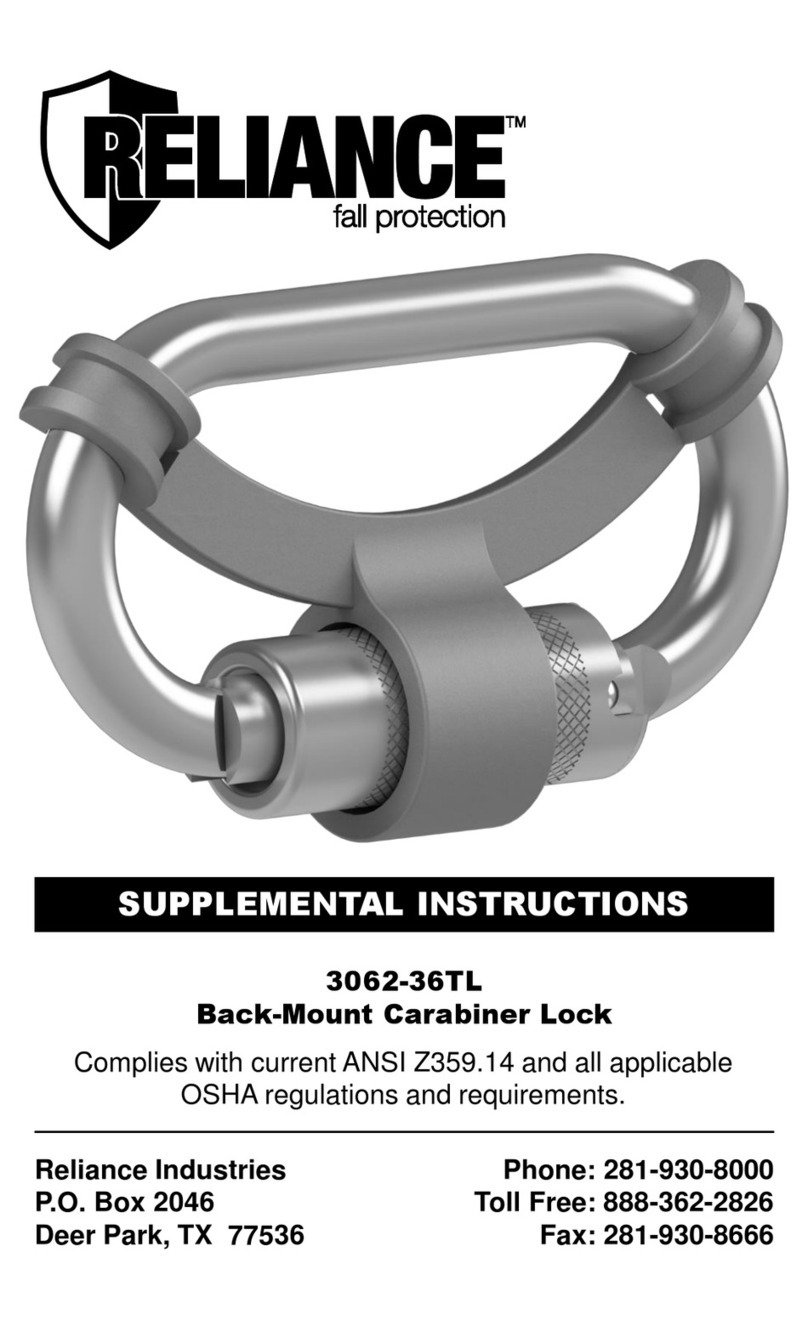
Reliance
Reliance 3062-36TL Owner's manual

Reliance
Reliance 4120 User manual
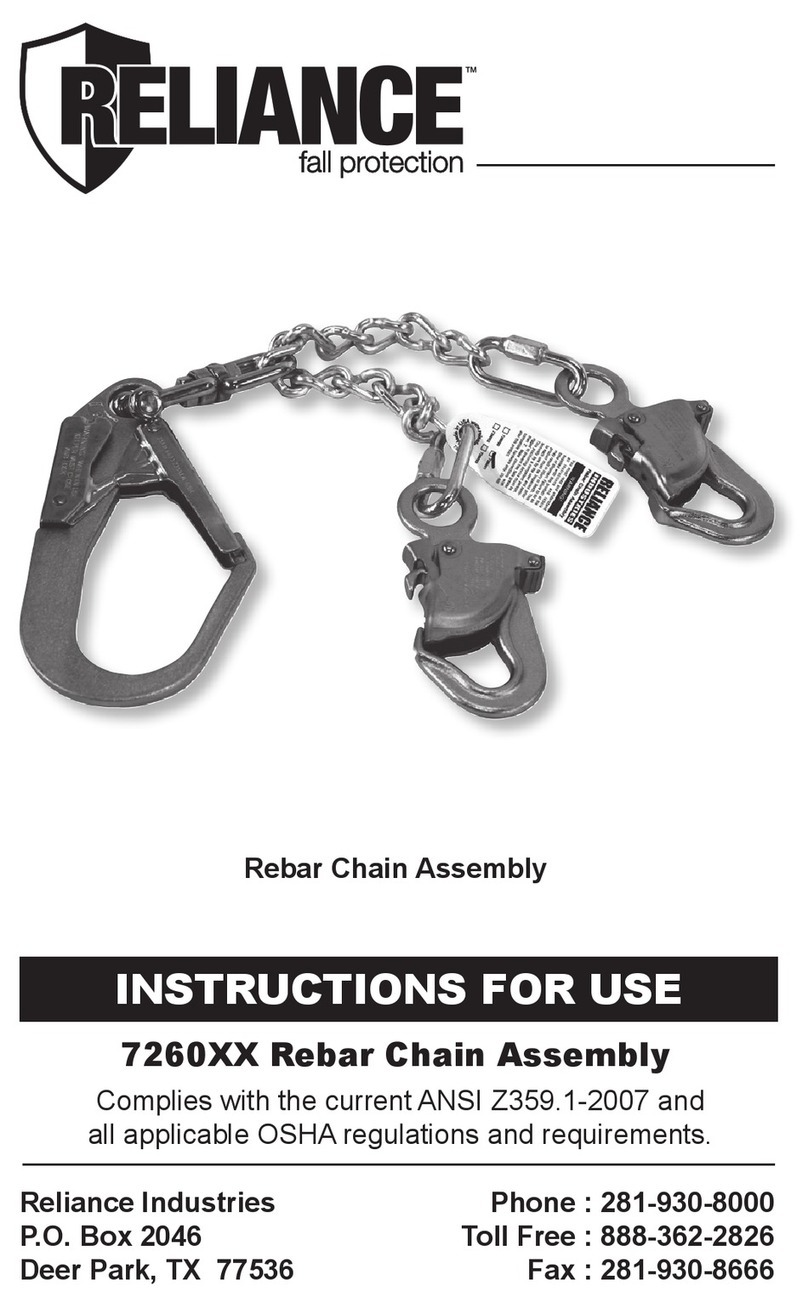
Reliance
Reliance 7260 Series User manual

Reliance
Reliance Skyloc 4 Series User manual
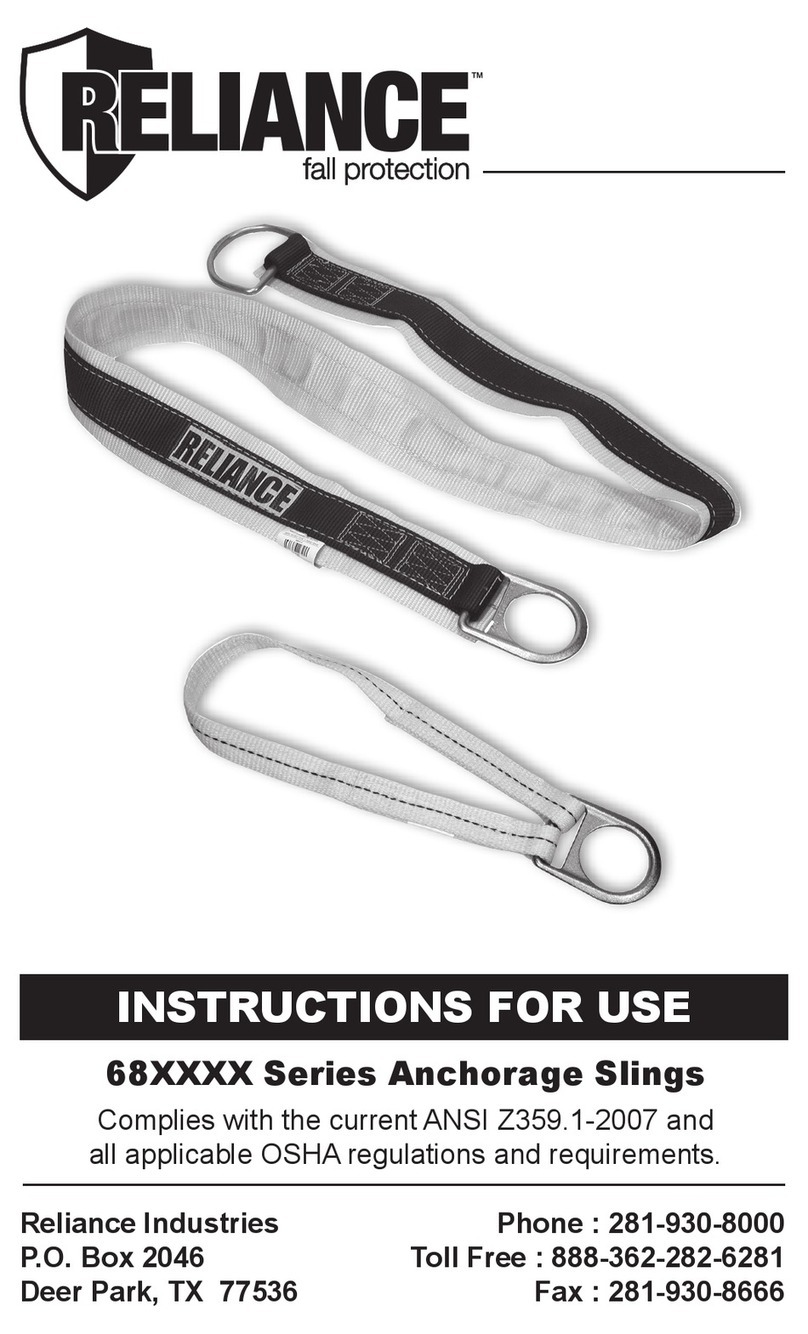
Reliance
Reliance 68 Series User manual
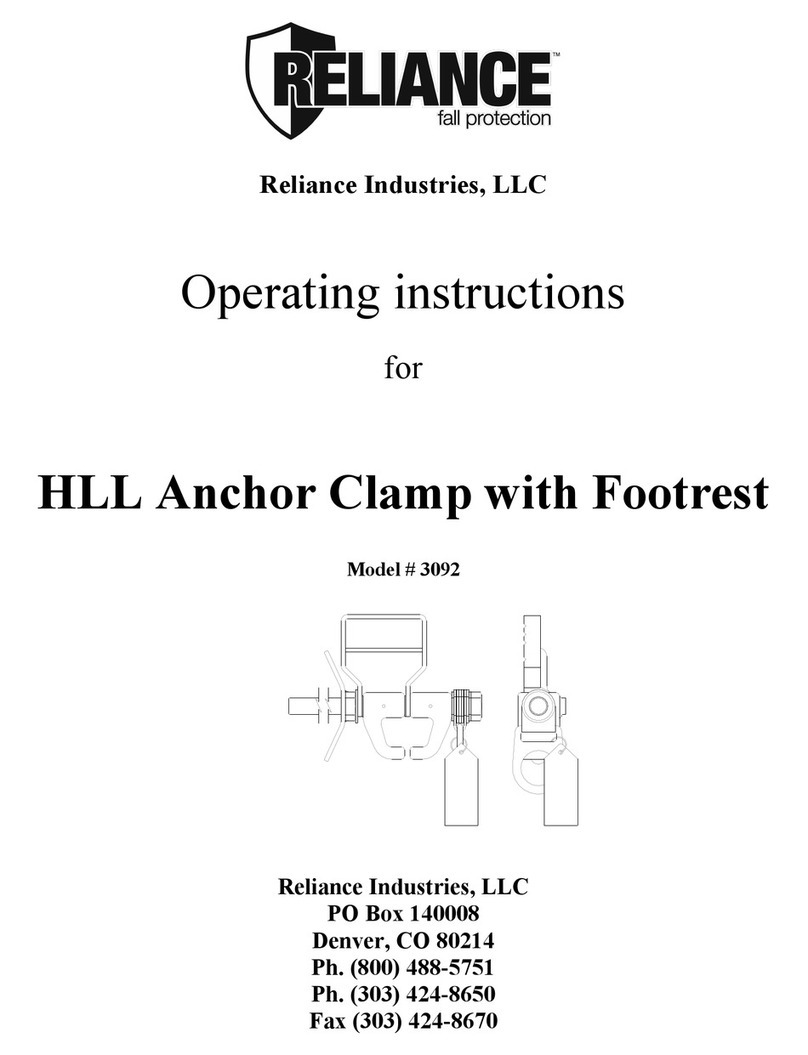
Reliance
Reliance 3092 User manual
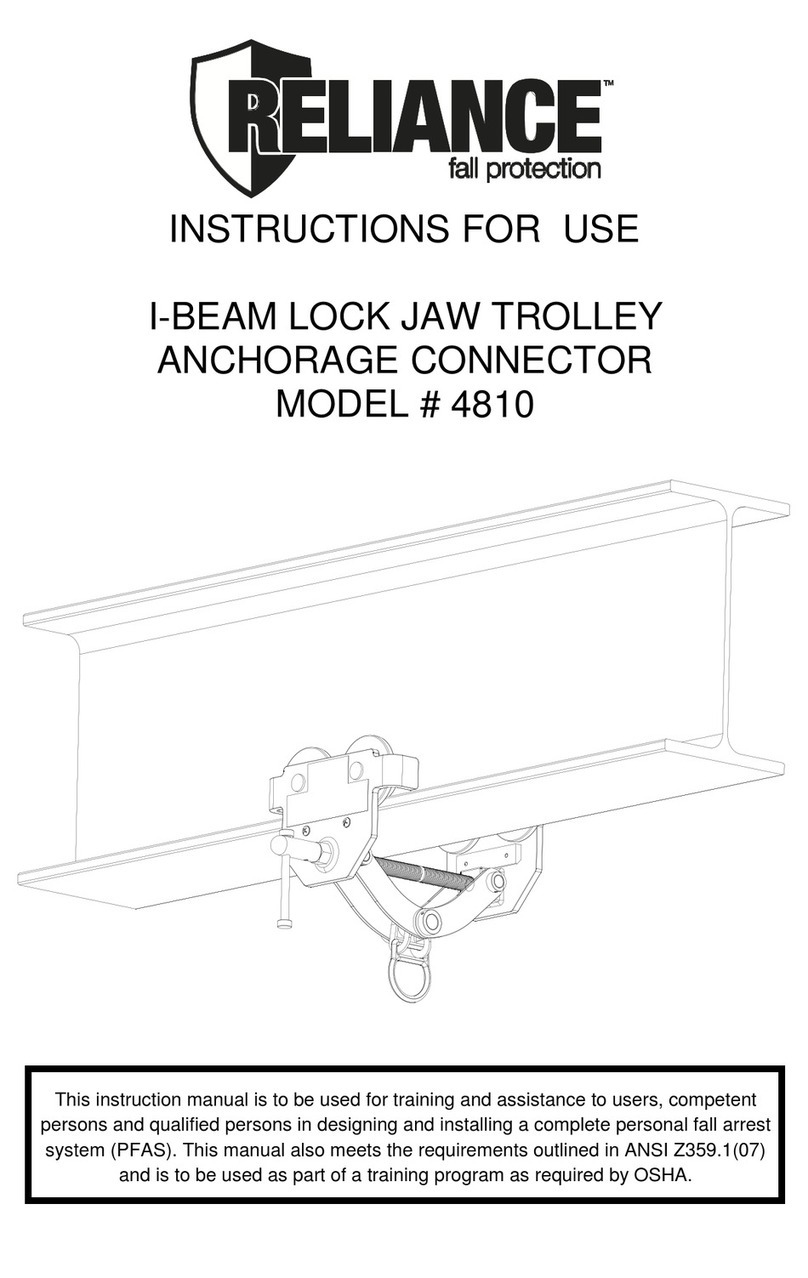
Reliance
Reliance 4810 User manual
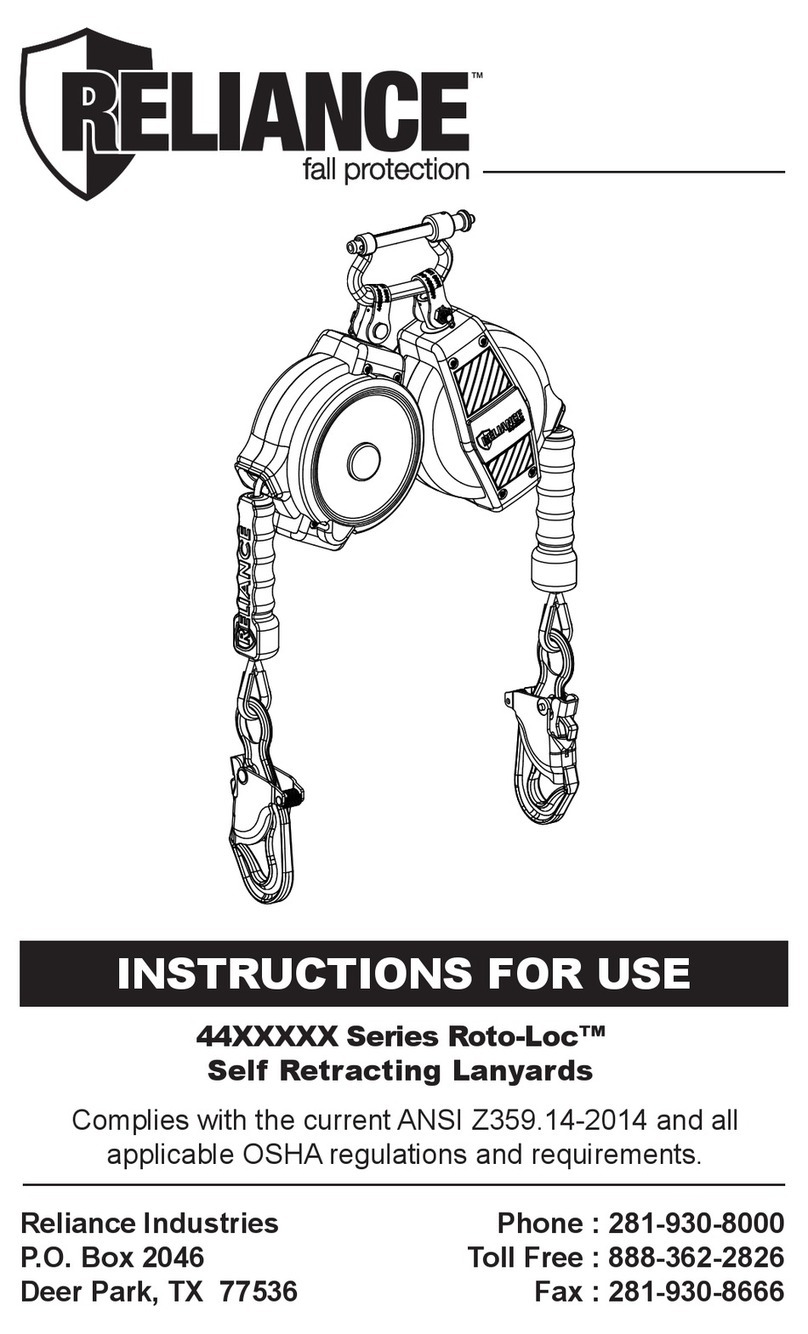
Reliance
Reliance Roto-Loc 44 Series User manual
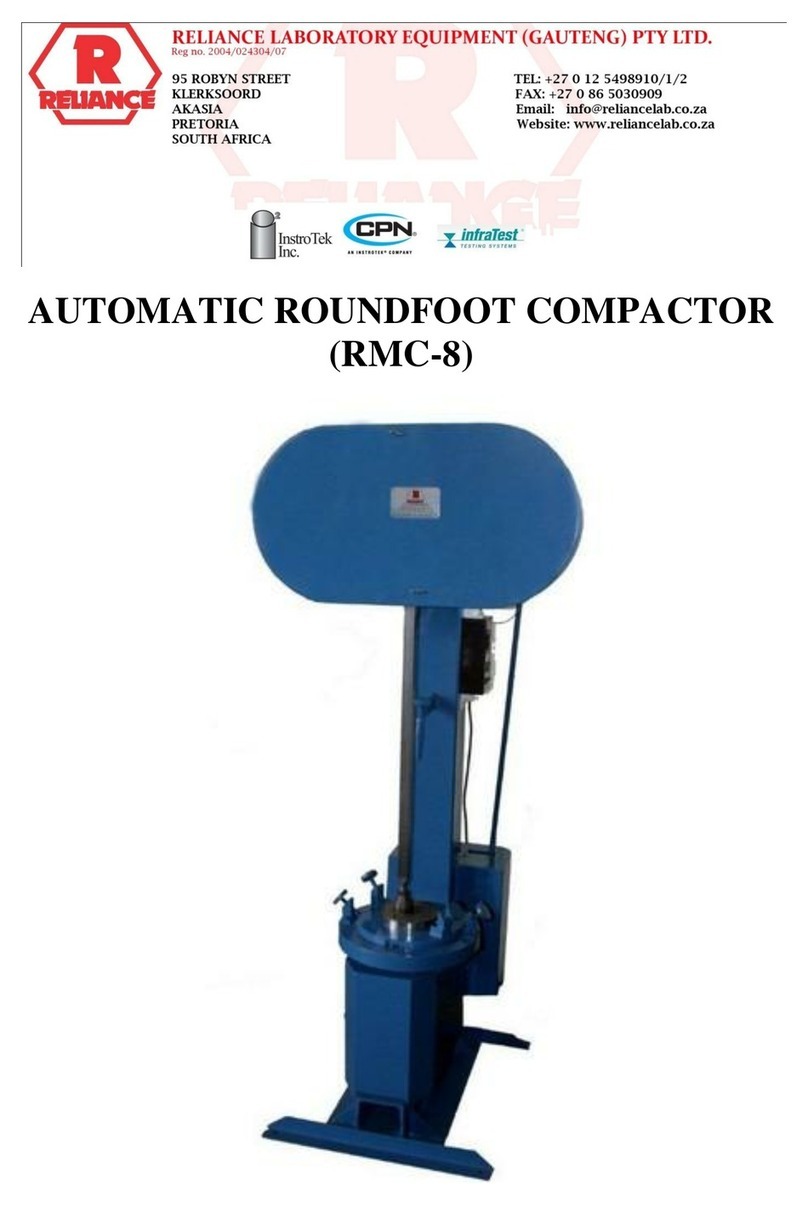
Reliance
Reliance RMC-8 User manual
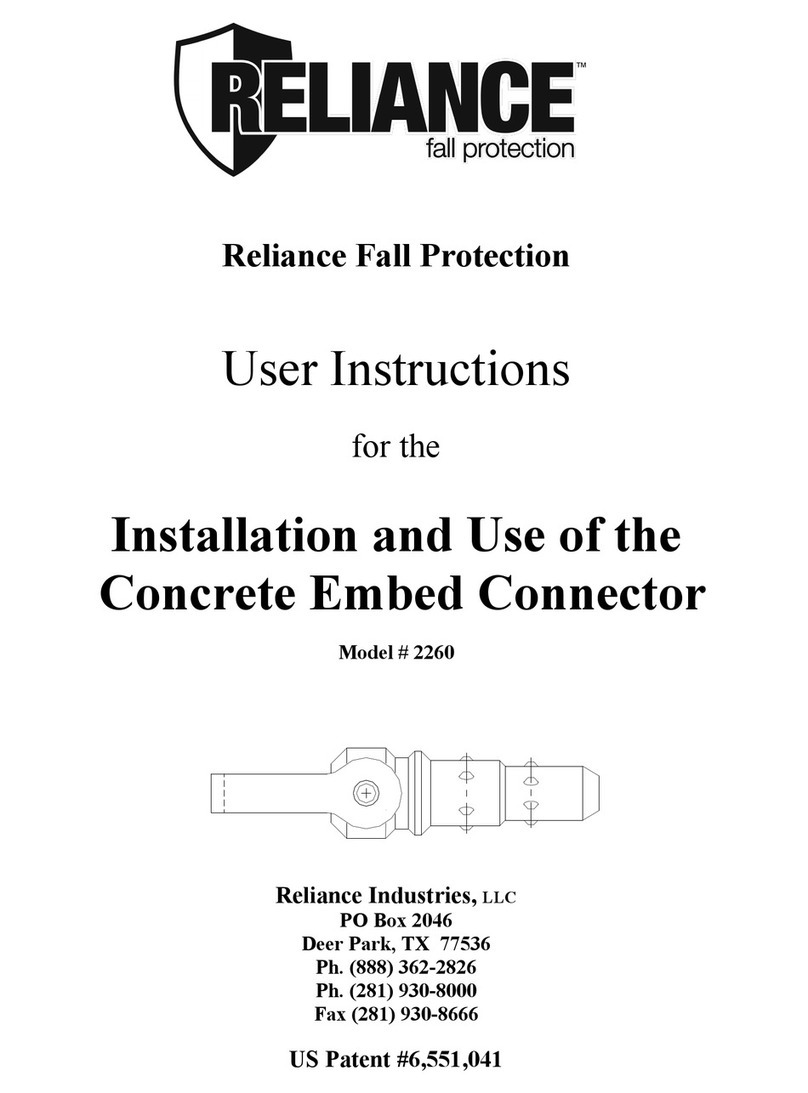
Reliance
Reliance 2260 User manual
